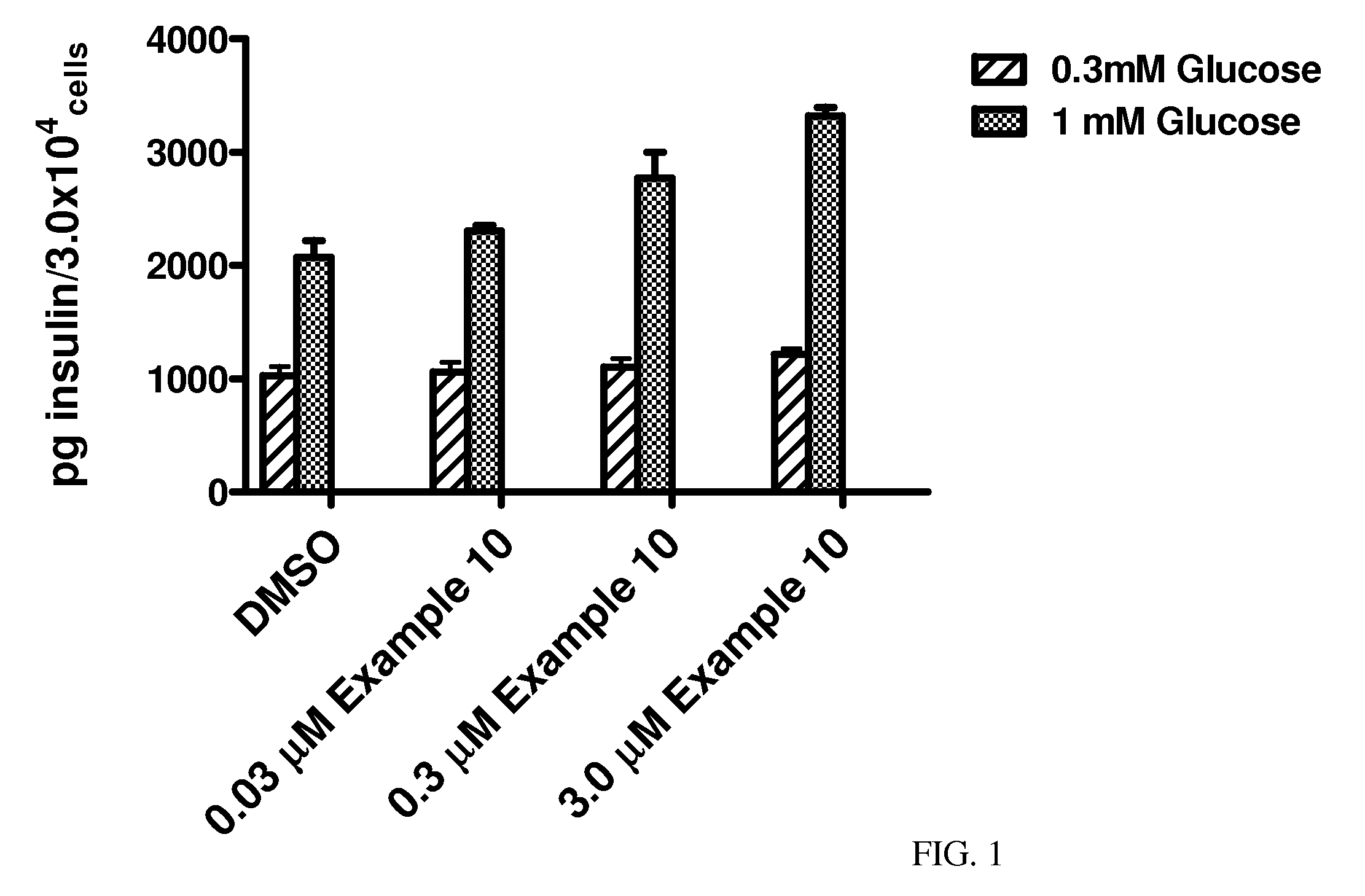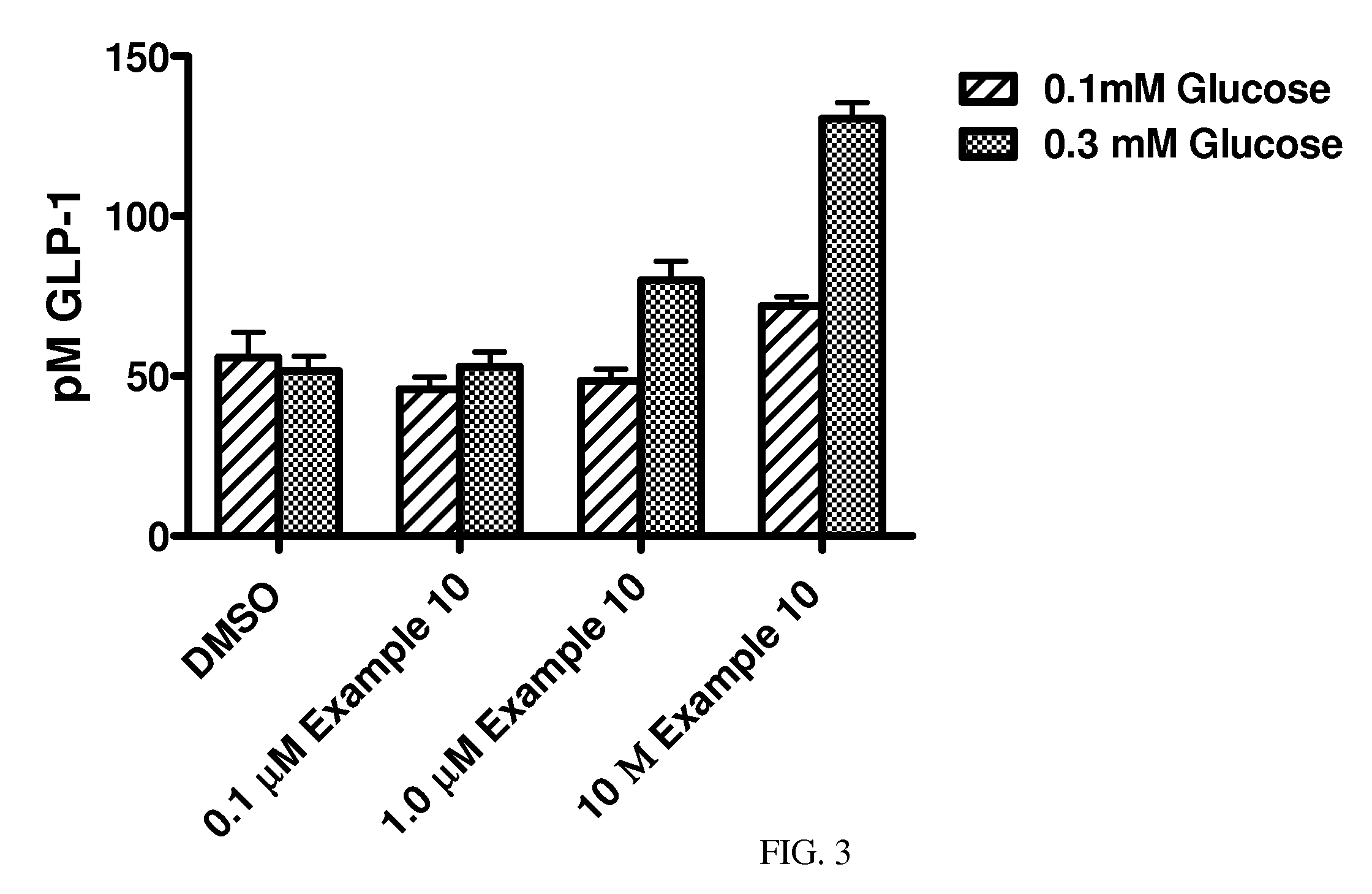Hydrazone Compounds and Their Use
- Summary
- Abstract
- Description
- Claims
- Application Information
AI Technical Summary
Benefits of technology
Problems solved by technology
Method used
Image
Examples
example 1
2-(3-Chlorophenylthio)-N′-(3,4-dimethoxybenzylidene)propanehydrazide
[0488]
[0489](a) Methyl 2-(3-chlorophenylthio)propanoate: To a stirred solution of 3-chlorobenzenethiol (1.0 g, 6.91 mmol) in CH3CN (14 mL) was added methyl 2-bromopropionate (0.77 mL, 6.91 mmol) along with K2CO3 (1.91 g, 13.83 mmol). The reaction was stirred at room temperature for 60 hours by which time the reaction mixture had become a white slurry. The reaction was diluted with CH2Cl2 and washed with water and brine. The organic layer was dried (Na2SO4), filtered and concentrated. The product (1.59 g, 99%) was used without further purification.
[0490](b) 2-(3-Chlorophenylthio)propanehydrazide: Methyl 2-(3-chlorophenylthio)propanoate (0.8 g, 3.48 mmol) was dissolved in MeOH (6 mL) and was added dropwise to a stirred solution of hydrazine hydrate (60%, 1.08 mL, 34.8 mmol) in MeOH (4 mL). The reaction mixture was heated to 50° C. via oil bath for 1 hour. The reaction mixture was diluted with CH2Cl2 and washed with wa...
example 2
N′-(3,4-dimethoxybenzylidene)-3-(1-methyl-1H-indol-3-yl)propanehydrazide
[0492]
[0493](a) Methyl 3-(1H-indol-3-yl)propanoate: To a stirred solution of 3-indolepropionic acid (5 g, 26.4 mmol) in MeOH (80 mL) was added conc. H2SO4 (0.5 mL). The reaction mixture was heated at reflux for 5 hours. The reaction mixture was allowed to cool to room temperature and the reaction solution was reduced to ⅓ volume at reduced pressure. The remaining solution was diluted with water and extracted with CH2Cl2. The organic phase was washed with saturated aq. NaHCO3 and brine and dried (Na2SO4). The material was purified on silica gel using EtOAc-hexanes (0 to 30%) and provided 5.16 g (96%) of the desired compound as a pale yellow oil which solidified upon standing.
[0494](b) Methyl 3-(1-methyl-1H-indol-3-yl)propanoate: To a stirred solution of methyl 3-(1H-indol-3-yl)propanoate (350 mg, 1.72 mmol) in DMF (3 mL) at 0° C. was added NaH (85 mg, 2.1 mmol; 60% in mineral oil). The cooling bath was removed af...
example 3
3-(3-Methyl-1H-indol-1-yl)-N′-((8-methylquinolin-6-yl)methylene)propanehydrazide
[0497]
[0498](a) Methyl 3-(3-methyl-1H-indol-1-yl)propanoate: A mixture of 3-methyl-1H-indole (0.5 g, 3.8 mmol), methyl 3-bromopropionate (0.44 mL, 11.0 mmol) and Cs2CO3 (3.7 g, 11.0 mmol) in DMF (20 mL) was stirred for 3 days at ambient temperature. The solvent was removed in vacuo and the residue was diluted with EtOAc and washed with water (4×50 mL) and dried (Na2SO4). The product was purified on silica gel using EtOAc-hexanes (0 to 10%).
[0499](b) 3-(3-Methyl-1H-indol-1-yl)propanehydrazide: To a solution of hydrazine hydrate (0.53 mL, 11.0 mmol; 60%) in MeOH (10 mL) was added a methanolic solution of methyl 3-(3-methyl-1H-indol-1-yl)propanoate (0.3 g, 1.3 mmol). The reaction mixture was then heated at 70° C. for 4 hours. The solvent was removed under reduced pressure. The residue was diluted with EtOAc and washed with water and brine and dried (Na2SO4). Evaporation provided the desired compound as a co...
PUM
| Property | Measurement | Unit |
|---|---|---|
| Molar density | aaaaa | aaaaa |
| Molar density | aaaaa | aaaaa |
| Molar density | aaaaa | aaaaa |
Abstract
Description
Claims
Application Information
 Login to View More
Login to View More - R&D
- Intellectual Property
- Life Sciences
- Materials
- Tech Scout
- Unparalleled Data Quality
- Higher Quality Content
- 60% Fewer Hallucinations
Browse by: Latest US Patents, China's latest patents, Technical Efficacy Thesaurus, Application Domain, Technology Topic, Popular Technical Reports.
© 2025 PatSnap. All rights reserved.Legal|Privacy policy|Modern Slavery Act Transparency Statement|Sitemap|About US| Contact US: help@patsnap.com



